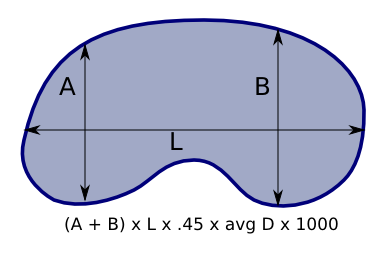Pond Volume and Litres Per Hour Calculators
Please note these are only to be used as a guide, please read all information below before using one of the Calculators. Also see: Average Turnover Rate
Please note these are only to be used as a guide, please read all information below before using one of the Calculators. Also see: Average Turnover Rate

Fish require feeding, and they produce waste. This increases the amount of pollutants present in the water which can affect the water quality; therefore a pond with a lot of fish will require filtering more frequently to keep the pond water clear, clean and healthy. Plants aid in filtering a pond, a pond with a lot of plants generally doesn’t need as high a flow-rate through a filter as one with few.
Pond types are divided into three categories for working out flow-rates;
High Fish Stocks or Turtle Pond
This is a pond with high stock rates of fish, turtles, or with very large fish, and no, or very few, plants. This type of pond will accumulate debris and toxins relatively quickly and therefore will need filtering at a higher rate. The entire volume of water in a Turtle pond should be passed through the filter once an hour to keep the water clear and healthy.
Goldfish Pond
A Goldfish pond is a type of pond that has an average amount of smaller to medium-sized fish and some areas of planting. This type of pond will not produce waste as quickly as a heavy fish populated pond or turtle pond and will only need to pass through a filter once every 1 ½ hours to keep it clean.
Decorative Pond
This is a pond with no or very few fish, and a lot of planting. A decorative pond will not accumulate toxins and debris as quickly as other types of pond, and water will only need to pass through a filter once every 2 hours.
Pond plants need the sun to establish and thrive, but too much sunlight will encourage the growth of algae in the pond, turning the water green. The more sunlight a pond receives, the greener it will become. Passing the water through a UVC will help to rid the pond of suspended algae. If the pond receives a lot of sunlight it will need to pass through the UVC more frequently to help combat the algae.
To work out the volume of your pond, you will need to know the following dimensions of the pond in meters;


With rectangular ponds with round ends you are effectively calculating the depth of two ponds, a round and rectangular pond added together.

The formula for kidney shaped ponds is very approximate. Round up to the nearest 500 liters when calculating the volume.

For elliptical cylinders you’r using the shortest (A) and longest (B) radius of the ellipse.

When calculating the volume of a cylinder, R refers to the radius.